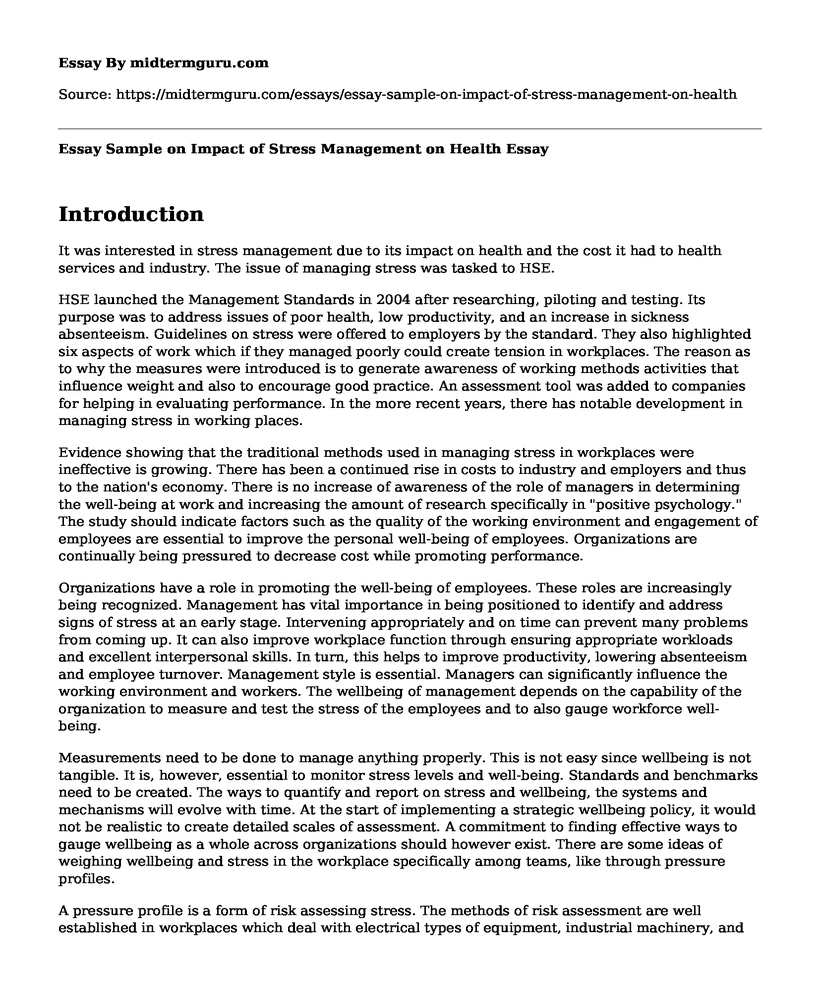Introduction
It was interested in stress management due to its impact on health and the cost it had to health services and industry. The issue of managing stress was tasked to HSE.
HSE launched the Management Standards in 2004 after researching, piloting and testing. Its purpose was to address issues of poor health, low productivity, and an increase in sickness absenteeism. Guidelines on stress were offered to employers by the standard. They also highlighted six aspects of work which if they managed poorly could create tension in workplaces. The reason as to why the measures were introduced is to generate awareness of working methods activities that influence weight and also to encourage good practice. An assessment tool was added to companies for helping in evaluating performance. In the more recent years, there has notable development in managing stress in working places.
Evidence showing that the traditional methods used in managing stress in workplaces were ineffective is growing. There has been a continued rise in costs to industry and employers and thus to the nation's economy. There is no increase of awareness of the role of managers in determining the well-being at work and increasing the amount of research specifically in "positive psychology." The study should indicate factors such as the quality of the working environment and engagement of employees are essential to improve the personal well-being of employees. Organizations are continually being pressured to decrease cost while promoting performance.
Organizations have a role in promoting the well-being of employees. These roles are increasingly being recognized. Management has vital importance in being positioned to identify and address signs of stress at an early stage. Intervening appropriately and on time can prevent many problems from coming up. It can also improve workplace function through ensuring appropriate workloads and excellent interpersonal skills. In turn, this helps to improve productivity, lowering absenteeism and employee turnover. Management style is essential. Managers can significantly influence the working environment and workers. The wellbeing of management depends on the capability of the organization to measure and test the stress of the employees and to also gauge workforce well-being.
Measurements need to be done to manage anything properly. This is not easy since wellbeing is not tangible. It is, however, essential to monitor stress levels and well-being. Standards and benchmarks need to be created. The ways to quantify and report on stress and wellbeing, the systems and mechanisms will evolve with time. At the start of implementing a strategic wellbeing policy, it would not be realistic to create detailed scales of assessment. A commitment to finding effective ways to gauge wellbeing as a whole across organizations should however exist. There are some ideas of weighing wellbeing and stress in the workplace specifically among teams, like through pressure profiles.
A pressure profile is a form of risk assessing stress. The methods of risk assessment are well established in workplaces which deal with electrical types of equipment, industrial machinery, and chemicals that are hazardous. Risk assessments are unlikely associated with the stress and wellbeing which are not tangible. This approach is however appropriate for stress and wellbeing. It involves noting down the negative sides of the job and the pressure required. For each force pointed observed, the time, reason and extent of the pressure point must be emphasized. The pressure points are then prioritized in order of how important they are as seen and agreed by managers. Remedial actions are then taken.
The motivation of workers is also essential for the excellent performance of an organization. Job enrichment is one way to create a work environment that motivates employees. It gives employees an opportunity to grow psychologically. Employees are given more responsibilities and alternations thus increasing their overall satisfaction. Analyzing of motivating potential is another way of motivating employees. For an employee to get excited, they need to experience three critical psychological states which include being experienced in responsibility, meaningfulness and finally knowing the results (Hackman, Richard & Oldham 1976). Managers can use the factors of analyzing to find the origin of motivating and satisfying problems. This helps in motivating employees since if some of the elements examined are low, the job enrichment method can be implemented.
References
Bandura, A. (1993). Perceived self-efficacy in cognitive development and functioning. Educational Psychologist, 28(2), 117-148.
Hackman, J. R., & Oldham, G. R. (1976). Motivation through the design of work: Test of a theory. Organizational behavior and human performance, 16(2), 250-279.
Cite this page
Essay Sample on Impact of Stress Management on Health. (2022, Sep 19). Retrieved from https://midtermguru.com/essays/essay-sample-on-impact-of-stress-management-on-health
If you are the original author of this essay and no longer wish to have it published on the midtermguru.com website, please click below to request its removal:
- Essay on Agricultural Food Production Challenges
- Research Paper on Organizational Leadership
- Social Work Leadership Assessment
- Teaching Men to Be Emotionally Honest - Research Paper
- Essay Sample on Nursing Leadership and Provision
- Essay Sample on Leadership Collaboration to Enhance Minimal Expenditure
- Leading Differently: Confucius' Checklist for Authority Figures - Essay Sample







